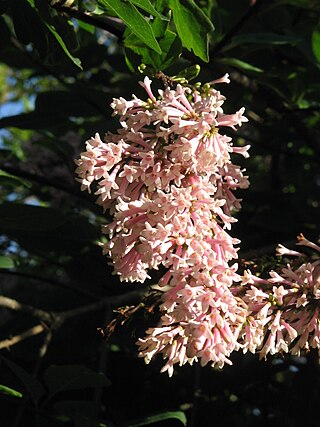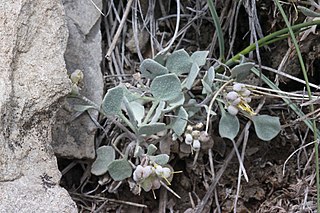
Syringa is a genus of 12 currently recognized species of flowering woody plants in the olive family or Oleaceae called lilacs. These lilacs are native to woodland and scrub from southeastern Europe to eastern Asia, and widely and commonly cultivated in temperate areas elsewhere.

Syringa vulgaris, the lilac or common lilac, is a species of flowering plant in the olive family, Oleaceae. Native to the Balkan Peninsula, it is widely cultivated for its scented flowers in Europe and North America.

Pachypodium ambongense is a species of plant in the family Apocynaceae. It was first published as a species of the genus Pachypodium in 1924 by the botanist Henri Louis Poisson.
Pachypodium bicolor is a species of plant in the family Apocynaceae.

Pachypodium brevicaule is a species of plant that belongs to the family Apocynaceae.

Gossypium arboreum, commonly called tree cotton, is a species of cotton native to Indian subcontinent and other tropical and subtropical regions of the Old World. There is evidence of its cultivation as long ago as the Indus Valley Civilisation of the Indus River for the production of cotton textiles. The shrub was included in Linnaeus's Species Plantarum published in 1753. The holotype was also supplied by him, which is now in the Linnean Herbarium in the Swedish Museum of Natural History.

Trichocladus is a genus of plant in family Hamamelidaceae, consisting of shrubs or small trees. The distinguishing features of the genus Trichocladus are as follows:

Calochortus albus is a North American species in the genus Calochortus in the family Liliaceae. It is also known by the common names fairy lantern, white fairy lantern, pink fairy lantern, lantern of the fairies, globe lily, white globe lily, white globe-tulip, alabaster tulip, Indian bells,satin bells, snowy lily-bell, and snow drops.

Lysimachia latifolia, sometimes called Trientalis latifolia, is a species of flowering plant in the family Primulaceae. It is known as starflower, chickweed-wintergreen, or Pacific starflower.

Adenorandia is a monotypic genus of flowering plants in the family Rubiaceae. It was described by Vermoesen in 1922. The genus contains only one species, viz. Adenorandia kalbreyeri, which is found from west-central tropical Africa.

Psychotria capensis, the bird-berry, is a southern African evergreen shrub or small tree. It belongs to a genus which is used medicinally in many regions, 'Psychotria' being from the Greek for 'rejuvenating', in reference to the healing properties of certain species. Kew lists some 2,000 species of Psychotria growing throughout the warmer regions of both hemispheres, but only two of them occur in southern Africa, namely P. capensis and P. zombamontana.
Meconopsis lancifolia is a plant species in the genus Meconopsis, in the family Papaveraceae. M. lancifolia is monocarpic, meaning that it flowers only once before dying.

Syringa oblatasubsp.dilatata, also known as Korean early lilac, is a subspecies of the species Syringa oblata in the genus Syringa, in the family Oleaceae.

Syringa emodi is a species in the genus Syringa, in the family Oleaceae. It is also known as Himalayan lilac.
Syringa pinetorum is a species in the genus Syringa, in the family Oleaceae.

Syringa tomentella is a species in the genus Syringa, in the family Oleaceae.

Physaria repanda, the Indian Canyon twinpod, is a species of plant in the family Brassicaceae distributed in Utah. It is a perennial wildflower.

Passiflora bogotensis is a climbing plant native to Colombia, in the genus Passiflora. It can also be found in Venezuela.

Verbesina centroboyacana is a species of shrub in the family Asteraceae endemic to Colombia.
Cardamine griffithii is a species of herb characterized by angled or grooved stems that are sparsely branched above and can reach heights of up to 60 cm. The plant is glabrous, meaning it lacks hair or trichomes.

















